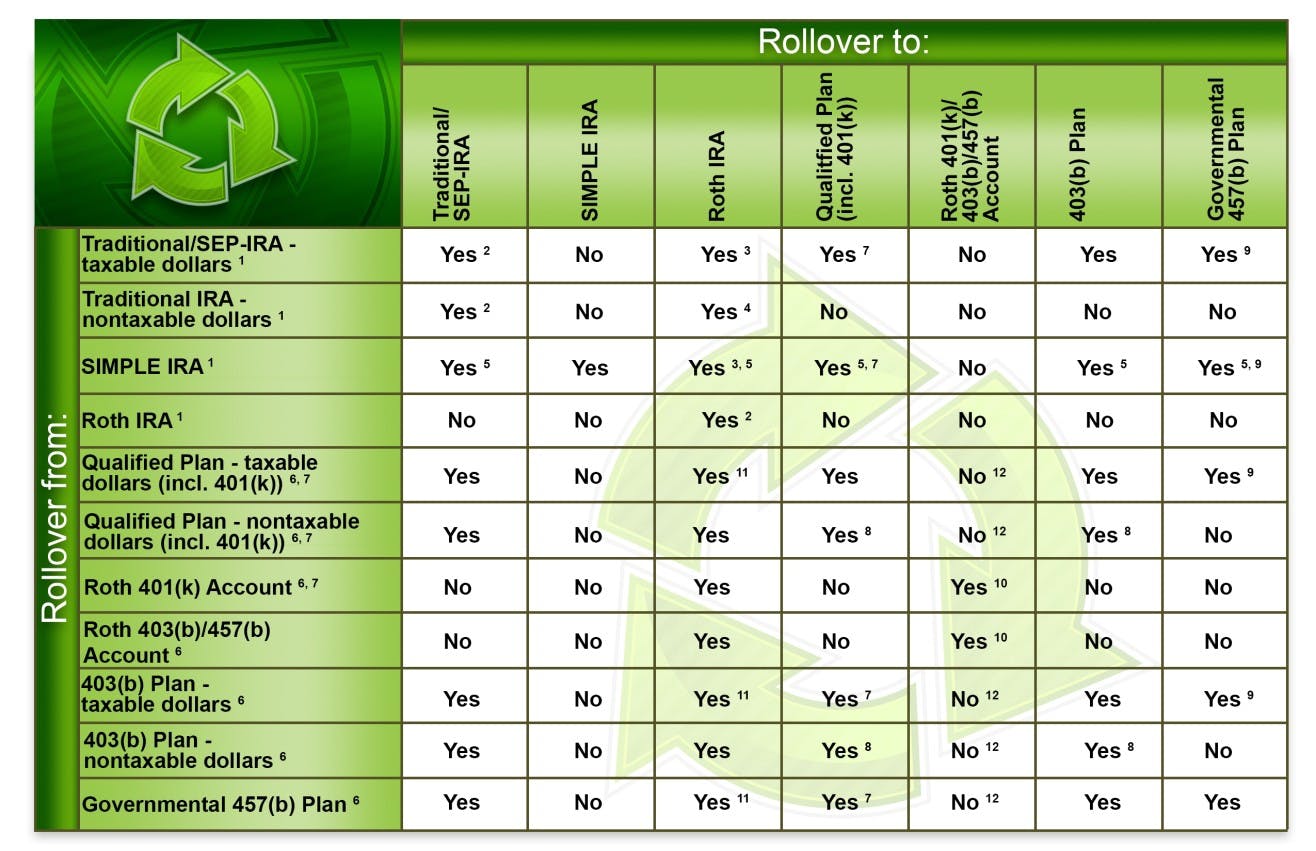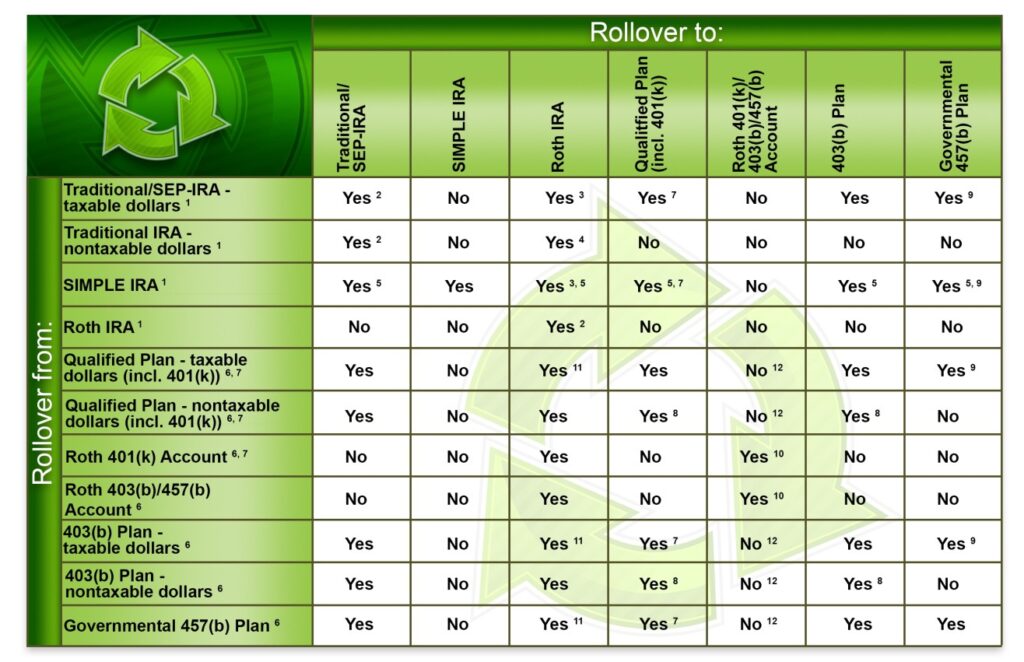Published on: 05/15/2015 • 6 min read
Rollovers

When evaluating whether to initiate a rollover always be sure to (1) ask about possible surrender charges that may be imposed by your employer plan, or new surrender charges that your IRA may impose, (2) compare investment fees and expenses charged by your IRA (and investment funds) with those charged by your employer plan (if any), and (3) understand any accumulated rights or guarantees that you may be giving up by transferring funds out of your employer plan.
In general, a rollover is the movement of funds from one retirement savings vehicle to another. You may want, or need, to make a rollover for any number of reasons–your employment situation has changed, you want to switch investments, or you’ve received death benefits from your spouse’s retirement plan. There are two possible ways that retirement funds can be rolled over–the 60-day rollover and the trustee-to-trustee transfer.
The 60-day, or indirect, rollover
With this method, you actually receive a distribution from your retirement plan and then, to complete the rollover transaction, you make a deposit into the new retirement plan that you want to receive the funds. You can make a rollover at any age, but there are specific rules that must be followed. Most importantly, you must generally complete the rollover within 60 days of the date the funds are paid from the distributing plan.
If properly completed, rollovers aren’t subject to income tax. But if you fail to complete the rollover or miss the 60-day deadline, all or part of your distribution may be taxed, and subject to a 10% early distribution penalty (unless you’re age 59½ or another exception applies).
Further, if you receive a distribution from an employer retirement plan, your employer must withhold 20% of the payment for taxes. This means that if you want to roll over your entire distribution, you’ll need to come
up with that extra 20% from your other funds (you’ll be able to recover the withheld taxes when you file your tax return).
The direct rollover
The second type of rollover transaction occurs directly between the trustee or custodian of your old retirement plan, and the trustee or custodian of your new plan. You never actually receive the funds or have control of them, so a trustee-to-trustee transfer is not treated as a distribution. Trustee-to-trustee transfers avoid both the danger of missing the 60-day deadline and, for employer plans, the 20% withholding problem.
With employer retirement plans, a trustee-to-trustee transfer is usually referred to as a direct rollover. If you receive a distribution from your employer’s plan that’s eligible for rollover, your employer must give you the option of making a direct rollover to another employer plan or IRA.
A trustee-to-trustee transfer (direct rollover) is generally the most efficient way to move retirement funds. Taking a distribution yourself and rolling it over makes sense only if you need to use the funds temporarily, and are certain you can roll over the full amount within 60 days.
Should you roll over money from an employer plan to an IRA?
In general, you can keep your money in an employer’s plan until you reach the plan’s normal retirement age (typically age 65). But if you terminate employment before then, should you keep your money in the plan (or roll it into your new employer’s plan) or instead make a direct rollover to an IRA?
There are several reasons to consider making a rollover. In contrast to an employer plan, where your investment options are limited to those selected by your employer, the universe of IRA investments is almost unlimited. Similarly, the distribution options in an IRA (especially for your beneficiary following your death) may be more flexible than the options available in your employer’s plan.
On the other hand, your employer’s plan may offer better creditor protection. In general, federal law protects your total IRA assets up to $1,245,475 (as of April 1, 2013)–plus any amount you roll over from a qualified employer plan–if you declare bankruptcy. (The laws in your state may provide additional protection.) In contrast, assets in an employer retirement plan generally enjoy unlimited protection from creditors under federal law, regardless of whether you’ve declared bankruptcy.
Use this rollover guide to help you decide where you can move your retirement dollars. A financial professional can also help you navigate the rollover waters. Keep in mind that employer plans are not legally required to accept rollovers. Review your plan document.
Some distributions can’t be rolled over, including:
Required minimum distributions (to be taken after you reach age 70½ or, in some cases, after you retire)
Certain annuity or installment payment
Hardship withdrawals
Corrective distributions of excess contributions and deferrals

1. Required distributions and nonspousal death benefits can’t be rolled over.
2. In general, you can make only one tax-free, 60 day, rollover from one IRA to another IRA in any one year period no matter how many IRAs (traditional, Roth, SEP, and SIMPLE) you own. This does not apply to direct (trustee-to-trustee) transfers, or Roth IRA conversions. (A special rule applies to 2014rollovers.
3. Taxable conversion
4. Nontaxable conversion
5. Only after employee has participated in SIMPLE IRA plan for two years.
6. Required distributions, certain periodic payments, hardship distributions, corrective distributions, and certain other payments cannot be rolled over; nonspousal death benefits can be rolled over only to an inherited IRA, and only in a direct rollover.
7. May result in loss of qualified plan lump-sum averaging and capital gain treatment.
8. Direct (trustee-to-trustee) rollover only; receiving plan must separately account for the after-tax contributions and earnings.
9. 457(b) plan must separately account for rollover–10% penalty on payout may apply.
10. Nontaxable dollars may be transferred only in a direct (trustee-to-trustee) rollover.
11. Taxable dollars included in income in the year rolled over.
12. 401(k), 403(b), and 457(b) plans can also allow participants to directly transfer non-Roth funds to a Roth account if certain requirements are met (taxable conversion).
______________________________________________________________________________________________
IMPORTANT DISCLOSURES
Financial Planning and Investment Advice offered through Avidian Wealth Management (STA), a registered investment advisor.
STA does not provide tax or legal advice and the information presented here is not specific to any individual’s personal circumstances. To the extent that this material concerns tax matters or legal issues, it is not intended or written to be used, and cannot be used, by a taxpayer for the purpose of avoiding penalties that may be imposed by law. Each taxpayer should seek independent advice from a tax professional based on his or her individual circumstances.
These materials are provided for general information and educational purposes based upon publicly available information from sources believed to be reliable—we cannot assure the accuracy or completeness of these materials. The information in these materials may change at any time and without notice.
As always, a copy of our current written disclosure statement discussing our services and fees continues to be available for your review upon request.
Please read important disclosures here
Get Avidian's free market report in your inbox

Schedule a conversation
Curious about where you stand today? Schedule a meeting with our team and put your portfolio to the test.*